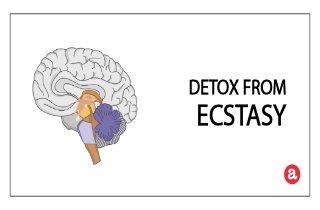Have you or a loved grown accustomed to ecstasy (MDMA)? Have you been taking them on a regular basis or only when partying?
In either case, detoxing from ecstasy occurs after use. What is the preferred way to detox from ecstasy? What can be expected during the time when ecstasy is leaving your body? How long does it take to detox and can you withdraw from ecstasy safely? We address these questions here and invite yours at the end.
Detox from ecstasy therapy
While many people claim that ecstasy is a recreational rather that habit forming drug, research has shown that regular users can and do develop symptoms of psychological dependence to ecstasy 3,4-methylenedioxy-N-methylamphetamine (MDMA), the main ingredient in ecstasy. What’s more, ecstasy abuse may have long term health consequences such as higher risk of cardiovascular diseases, cognitive and mood disorders.
Knowing this, how can you stop using ecstasy safely? It is advisable that any case of detox therapy is supervised by a medical professional, especially ifor heavy users. However, it is possible to detox from ecstasy at home as well. What are some of the common therapies used?
Generally, individuals undergoing detox from MDMA should keep hydrated. Sometimes doctors would prescribe medications, for instance 2-3 mg/kg Dantrolene sodium, three times a day. This is to help relaxing the muscles and lessening rigidity and body temperature fluctuations. It is also important to note that following the detox phase, periodic health checks and psychological counseling can help individuals who are physiologically dependent on ecstasy to address addiction.
Detox from ecstasy time
During any period of detox, the body eliminates drugs or substances from the central nervous system. After a period of dependence, people can experience withdrawal symptoms as a result of the drug’s absence. While infrequent, ecstasy dependence can occur. And note also that although ecstasy can be detected in the urine for only a short period of time (30 to 48 hours), it takes from 2 to 4 days for the drug toxins to leave the body.
People usually in a detox clinic from 3-5 days, but length of stay varies depending how sick they become during the process, their psychological state, and other factors. A person may also stay longer if they are waiting to directly enter a treatment program.
Generally, the duration and intensity of ecstasy withdrawal symptoms that can occur during this stage depend a great deal on the level of use, including dosage amounts, frequency and duration of use. Chronic and long term users may need longer than occasional users to recover and may experience more intense symptoms.
Detox from ecstasy symptoms
Once the effects of ecstasy start to fade away, the withdrawal symptoms can be quite uncomfortable, especially for chronic users. The most common psychological and physical symptoms of ecstasy withdrawal that occur during ecstasy detox include:
- anhedonia (difficulty feeling pleasure)
- dehydration
- depression
- fatigue
- lack of motivation
- lethargy
If heavy users decide to go for a cold turkey detox, they may require medical surveillance as severe withdrawal symptoms are possible to occur such as:
- acute renal failure
- altered mental status
- changes in blood pressure
- coagulopathy (difficulty with the blood’s ability to clot)
- convulsions
- hepatotoxicity (chemical-driven liver damage)
- hypo or hyperthermia (conditions of under heating or over heating)
- tachycardia (an abnormally rapid heart rate)
Some of the above mentioned symptoms may as well occur when ecstasy is taken in conjunction with other drugs for the sake of intensifying its effect. Depending on their intensity, detox from ecstasy symptoms can be treated either at home or under medical surveillance.
Detox from ecstasy at home
Inpatient/outpatient surveillance during ecstasy detox usually applies to heavy users, as severe reactions to the drug absence may occur.
The goal of detox is to keep people medically stable and safe during the withdrawal, and then assist people to ongoing treatment and recovery. And while it’s possible to detox from ecstasy at home, it is preferred that users seek professional assistance. In fact, you should first consult a medical professional for approval to stay at home during MDMA detox.
Those people who may be considered to detox from ecstasy at home are individuals who:
- are highly motivated to complete the detoxification process
- are in general good health
- are not diagnosed with an underlying mental health disorder
- can be supported by loved ones in a healthy (non-drug using) environment
- have no prior history of severe detox symptoms
It is important to keep track of the body temperature during ecstasy detox to avoid drastic fluctuations. It is of utmost importance to stay hydrated as s/he could have lost large amounts of fluid while high on the drug. In cases of any severe withdrawal symptoms, seek medical help immediately.
Detox from ecstasy questions
We hope to have addressed your questions about detox from ecstasy here. But if you have any additional questions about detox from ecstasy or would like to share your personal experience, please use the comments section below. We will try to get back to you with a personal and prompt reply.









Related Posts